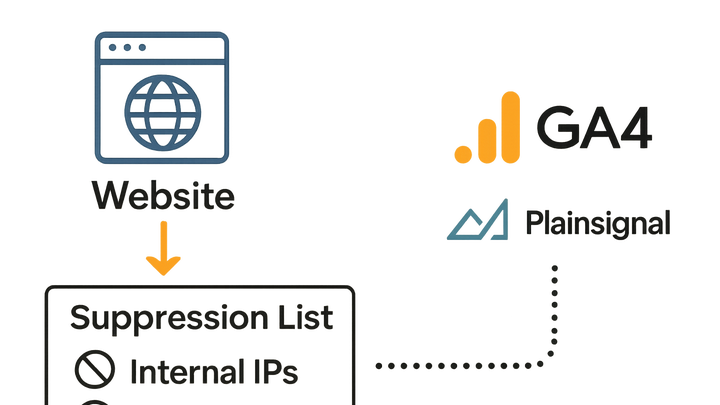Published on 2025-06-22T06:17:26Z
What is a Suppression List in Analytics? Examples for GA4 and PlainSignal
A suppression list in analytics is a mechanism for excluding specific traffic or events from data collection to ensure that analytics reports only reflect relevant, high-quality data. This is crucial for removing test traffic, internal visits, or user segments who have opted out of tracking, thereby supporting accurate insights and protecting privacy. Suppression lists help maintain data integrity by filtering out unwanted noise such as bots and crawlers. In tools like Google Analytics 4 (GA4), suppression lists are configured via data filters and internal traffic definitions, while privacy-focused platforms like PlainSignal enable suppression through script customization or dashboard list management. Regularly auditing and testing these lists ensures they continue to serve accurate measurement goals.
Suppression list
A suppression list excludes internal, bot, or opted-out traffic from analytics to maintain data accuracy and privacy compliance.
Purpose of a Suppression List in Analytics
Suppression lists help maintain data integrity by excluding unwanted or irrelevant traffic from analytics reports. They ensure analysis reflects genuine user engagement and support privacy compliance with regulations like GDPR and CCPA.
-
Exclude internal traffic
Prevents visits from employees, testers, and developers from skewing performance metrics.
-
Filter out bots and crawlers
Blocks automated scripts and web crawlers that might inflate pageview and session counts.
-
Ensure privacy compliance
Respects user opt-outs and regulatory requirements by not recording data from opted-out users.
Implementing Suppression Lists in Google Analytics 4
GA4 uses data filters to exclude specific traffic before it appears in reports. You can define rules based on IP addresses or user parameters to suppress unwanted data.
-
Define internal traffic rules
In Admin > Data Streams > Configure tag settings, set up traffic rules based on IP ranges or custom parameters to classify internal traffic.
-
Activate data filters
Go to Admin > Data Settings > Data Filters and apply the internal traffic filter. Choose between Testing and Active modes.
-
Verify in debugview
Use DebugView to confirm that defined traffic is correctly excluded without affecting legitimate user data.
Implementing Suppression in PlainSignal Analytics
PlainSignal, a cookie-free analytics solution, allows suppression of specified traffic through script customization or dashboard-managed lists. This ensures streamlined, privacy-focused data collection.
-
Suppress via script modification
Add custom logic in the PlainSignal snippet to skip loading the analytics script for certain users or conditions.
-
Example tracking code
<link rel="preconnect" href="//eu.plainsignal.com/" crossorigin /> <script defer data-do="yourwebsitedomain.com" data-id="0GQV1xmtzQQ" data-api="//eu.plainsignal.com" src="//cdn.plainsignal.com/plainsignal-min.js"></script>
-
-
Manage suppression lists in dashboard
Upload or enter a list of user identifiers (e.g., hashed emails or device IDs) in the PlainSignal dashboard to automatically omit these entries from data collection.
Best Practices for Suppression Lists
Follow best practices to ensure your suppression lists remain effective and do not inadvertently remove legitimate data. Regular maintenance and clear documentation are key.
-
Regularly review lists
Periodically audit IPs, user IDs, and other entries to keep the suppression list current and relevant.
-
Document suppression criteria
Maintain clear records of why and when entries were added, aiding transparency and team collaboration.
-
Test before enforcing
Use testing modes or staging environments to validate suppression rules, ensuring they do not exclude genuine user traffic.
